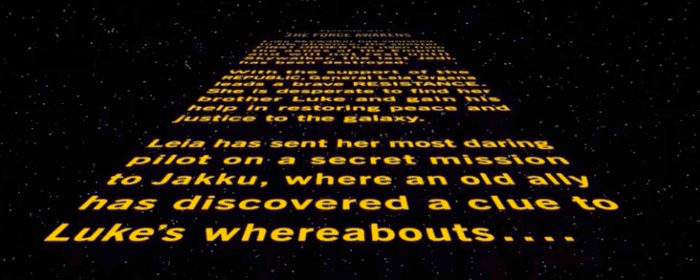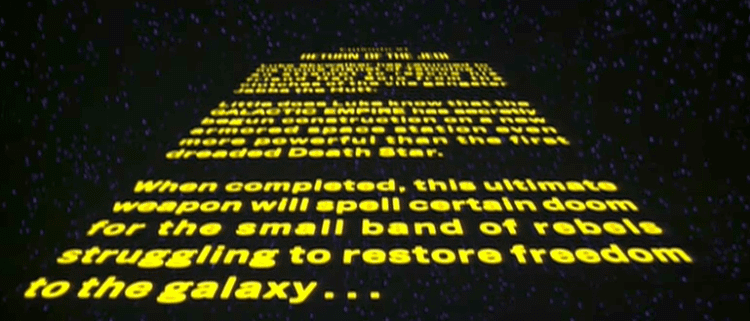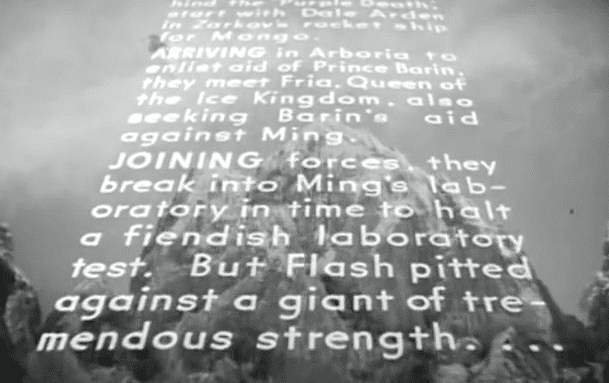Here’s a source of many sleepless nights:
Some time ago, in a galaxy not so far away, I noticed a strange four dot ellipsis in the opening sequence of Star Wars: The Force Awakens. Had someone messed up? Or was it intentional — then what’s up with that?
Here’s the classic opening sequence of Star Wars:

Then, at the end of the opening crawl, we see that mysterious four dot ellipsis yet again:

As a professional communicator and Swede with international clients, I’m always striving to improve my English. And, you know… it’s Star Wars.
The Four Dots in Star Wars
In a movie franchise as meticulously crafted as Star Wars, I couldn’t imagine a scenario where the creators would add a fourth dot by mistake. And true to form: The four dot ellipsis occurs in all the other Star Wars intros as well!
Well, almost1. There’s one exception: The opening crawl in Star Wars: The Return of the Jedi:

The final paragraph of the opening crawl has only three dots! The four dots can’t all be typos, right? And if they aren’t — what about the three dots in Star Wars: The Return of the Jedi?
The Classic Three Dot Ellipsis
Before we dive deeper into this mystery, let’s have a look at how to use the regular three dot ellipsis. It could be used to indicate an unfinished sentence or thought:
“I was going to…”
(Since the three dots have an affinity with the phrase, there shouldn’t be a space in between the last word and the three dot ellipsis.)
It can also be used to signal that something, perhaps ominous, is about to happen:
“But the story didn’t end there…”
Some style guides suggest that these types of punctuation marks should be used with spaces in between them:
“But the story didn’t end there. . .”
However, using spaces is more of a stylistic choice, but not a very practical one: This could result in unwanted line breaks when using today’s word processors2. Still, outside of literary uses, the three dot ellipsis is commonly used in formal texts to indicate editorial omissions.
Original:
“Doctor Spin is a PR blog written and edited by Jerry Silfwer.”
With editorial omission:
“Doctor Spin is a PR blog … by Jerry Silfwer.”
The edited version still makes it a bit unclear; the only indication that the ellipsis wasn’t in the original text is the fact that it has a space before and after. This is why many style guides recommend using a parenthesis for omissions:
“Doctor Spin is a PR blog (…) by Jerry Silfwer.”
But what if the quoted text already contains these types of omissions? Again, some style guides then recommend keeping the author’s omissions with parenthesis, (…), and use brackets for your omissions, […].
Confusing?
Well, we have left regulatory terrain and entered the land of style. Personally, whenever I use the three dot ellipsis for omissions, I prefer brackets:
“Doctor Spin is a PR blog […] by Jerry Silfwer.”
In rare cases when you’re quoting someone who has used the three dot ellipsis, use the three dots without brackets — or with a parenthesis. Since such cases are scarce, it’s certainly the path of least resistance. One could use brackets with spaces, [. . .], which arguably looks fine stylistically, but it isn’t a great choice due to unwanted line breaks.
So, what about the four dot ellipsis, then?
The Four Dot Ellipsis Exists
The four dot ellipsis actually exists, believe it or not. Or, it sort of exists. If you use a three dot ellipsis (without parentheses or brackets) to remove words at the end of the sentence, it would theoretically look like this:
“Doctor Spin is a PR blog… . It was launched in 2002.”
It sort of makes sense, right? Words at the end of the sentence have been omitted, but it has to also be clear to the reader that there’s a punctuation before the following sentence. However, in use, the space between the first three and the last dot is a problem. Because the last dot is quoted and such dots don’t have any spaces in-between them and the last word.
Hence, there’s no space:
“Doctor Spin is a PR blog…. It was launched in 2002.”
Four dots in a row, go figure! Love it.
Still, and this is worth mentioning again, it’s not actually a “four dot ellipsis” per se — it’s just a three dot ellipsis directly followed by “normal” dot. Or a “normal” dot followed by a three dot ellipsis. Theoretically, you could also use brackets to illustrate the exact same thing:
“Doctor Spin is a PR blog […]. It was launched in 2002.”
In my opinion, brackets are much clearer. They make it easier for any reader to understand what’s going on.
So what about Star Wars, then?
The Star Wars Mystery
If the four dot ellipsis in Star Wars is intentional, and it seems like it is, then those four dots represents a three dot ellipsis omitting the rest of the sentence, then followed by a regular dot:
“A long time ago in a galaxy far, far away […].”
Or:
“A long time ago in a galaxy far, far away. […]”
From an art director’s viewpoint, the use of parenthesis or brackets would have given each intro an unwanted touch of “academia.” So, the four dot ellipsis intro used in all of the Star Wars movies is actually correct. Or, at least, not necessarily wrong.
But what about the four dot ellipsis ending the opening crawl of all regular Star Wars movies (except for Star Wars: The Return of the Jedi)?
Unlike the intro texts, all final opening crawl sentences seem to be fully completed — with no words omitted at the end of those sentences. They seem like sentences indicating that the story now continues — which should call for a three dot ellipsis, right? Still, you and I can’t make that decision; it’s ultimately the prerogative of the creator.
It’s a fictitious story and the one who made it up has the final say, period. (Pun intended.) The opening crawls could be excerpts taken from a Star Wars library in some Jedi temple somewhere.
We can’t know if those sentences have words omitted or not.
Who’s to say that we’re reading a representation of the text — and not the actual text? If the latter is true, we can’t expect to see any quotation marks.
Inspired by Flash Gordon
According to forums and fan sites, George Lucas, the father of the Star Wars franchise, was inspired by the opening crawl of Flash Gordon:

We can clearly see how the creators of the Flash Gordon opening crawl uses a four dot ellipsis — even using a space between the final dot and the following three dot ellipsis, thus indicating that the final sentence is complete, but that there are words omitted from the “original source” of the text.
Maybe the four dots in Star Wars is a discreet hat tip from George Lucas to Flash Gordon? Even though we might suspect that not all uses of the four dot ellipsis in Star Wars are completely grammatical, George Lucas can get away with it. He’s a bonafide genius, after all. Which leaves us with one remaining question mark:
The three dot ellipsis in Star Wars: The Return of the Jedi.
Was that a mistake, then?
The creators could argue that that particular sentence had no omitted words compared to the “original source.” And, even though it wasn’t the final Star Wars movie, it was, at least at the time, the final chapter of the Star Wars saga. Maybe, in the fictitious world of Star Wars, nothing more had been “written down” yet?
Maybe the saga’s timeline had, with The Return of the Jedi, caught up to “present day”?
“It’s Not Over Yet….”
I doubt that George Lucas will ever comment on the four dot ellipsis. Right now, I only wish for two things:
- That we in the upcoming Star Wars: The Last Jedi, get to see the return of the four dot ellipsis, both in the intro text and in the opening crawl.
- That we in the final instalment of this new Star Wars trilogy, set in the future of episodes I-VIII, get to see the three dot ellipsis ending the final paragraph of the opening crawl, just like it did in Star Wars: The Return of the Jedi, to indicate that we, the fans, have caught up with “present day” on the saga’s timeline yet again!
What do you think? Do we need the four dot ellipsis? Please share in the comments.
Photo by Daniel Cheung on Unsplash.
---------------------
- The standalone prequel Rogue One didn’t have the classic tilted intro crawl, but it, too, starts with “A long time ago in a galaxy far, far away….” and — voilà! — the four dots.
- Some people use double-spaces as formatting tools between sentences and first line indentations, but unless you’re using a typewriter, it’s better to leave typography to the machines.
